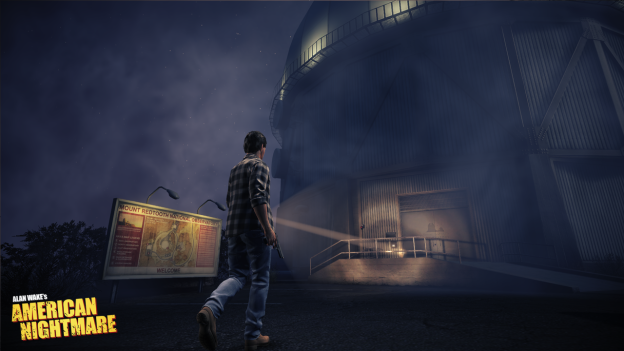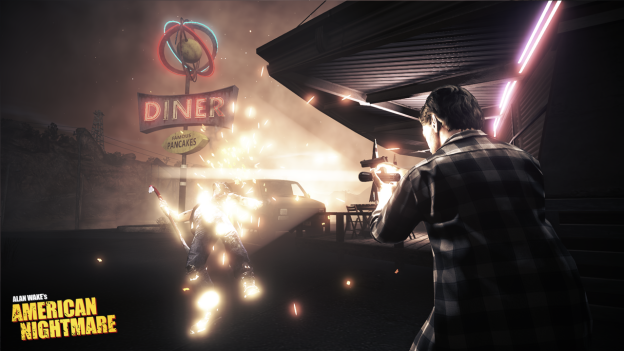
Remedy’s Xbox 360 exclusive Alan Wake was a breath of fresh air for video games when it finally arrived in 2010 after an extended development period. Here was a game that seemed to be putting story ahead of everything else. It was fun to play, with combat built around mechanics involving light and shadow, but the narrative was the real hook, with its serial TV drama-style presentation and episodic arrangement.
Remedy’s recently confirmed early 2012 Xbox Live Arcade release Alan Wake’s American Nightmare ALSO has a story, but it’s one that is best viewed as a spin-off. In fact, the plan for a game technically existed before a story was even in the picture, as I learned during a recent sitdown in New York City with Remedy CEO Matias Myllyrinne and head of franchise development Oskari Häkkinen.
“Alan Wake was a tip of the hat to Alfred Hitchcock, to Stephen King, to Lost, and this has a different feel and a different focus,” Häkkinen told me. “Some of the influences are pointing more toward Quentin Tarantino, with a Dusk ‘Til Dawn-ish grindhouse feel to it. More pulp fiction.”
“So how this came about– after Alan Wake, we were looking at what people liked and it seemed kind of universally agreed that everyone liked the story, the characters, the cinematics and the thriller-esque feeling it. But one thing that a lot of people were saying was that they would’ve liked to have seen a further escalation in the combat, perhaps some different types of weapons and enemies as well. More variation as the story progressed.”
The team used that feedback to create a sort of “white room sandbox,” as Häkkinen described it, filling the environment with weapons and enemies just to test out some new ideas. This in itself turned out to be fun for all; without any sort of built-in leaderboard, the devs took to keeping track of high scores on a whiteboard in the office. The more they played it, the more they realized that they were onto something.
“We put lots of wild stuff in there,” Häkkinen said. “It just seemed like the perfect fit for Xbox Live Arcade. That’s how it started off.”

From there the idea was pitched over to Remedy creative director Sam Lake, who saw a good opportunity to tell another Wake story. He also acknowledged that the more outrageous sampling of weapons and enemies cooked up for what we now know as Alan Wake’s American Nightmare wouldn’t necessarily fit within the narrative framework established in the 2010 game. That’s where the next piece of the puzzle fell into place, with Night Springs.
The story in American Nightmare puts players in control of Wake as he lives through an episode of the TV series Night Springs, a Twilight Zone-like show in the Wake universe that players got glimpses of in the previous game. “These kind of weapons and enemies fit in perfectly,” Häkkinen said. “It’s a little bit lighter and it’s something anyone could jump on board with. But for the fans out there, there’s tons of optional story content as well that connects the dots to the first game and explains why we are here.”
Myllyrinne chimed in at this point. “I think the other consideration we had was, we felt that the medium needs to be reflected in the content. So when you play an XBLA game– even though we’re challenging a lot of the conventions [with American Nightmare], people want to pick it up and play [an XBLA game] to have fun. I think having something like the [Fight Till Dawn survival] arcade mode makes perfect sense for that medium.”
“When we look at the story mode [in American Nightmare], it’s a more contracted experience compared to a full-on 12 to 15 hour adventure. We wanted to introduce these elements really rapidly and make sure that players can jump in and [just] enjoy them, get right down to the core of the ‘fight with light’ combat mechanics and also a story that has a meaningful structure to it.”
The big surprise for me in all of this was hearing that American Nightmare, a spinoff of one of the most successfully executed game narratives… well… ever, was actually born out of a relatively simple and straightforward arcade-style survival mode. What’s more, that survival mode itself exists only because of the dev team’s efforts to respond to critical and fan feedback. I mentioned this and got nods of agreement from the Remedy guys.
“We’ve done games before where we started more from a narrative perspective. This time, the broad narrative was done already because we’ve plotted out Wake’s journey, if you will,” Myllyrinne explaied. “We started very much from a gaming perspective here. I wish I could say we had a grand design, but it was more iterative and just kind of came from the arcade mode.”
“It’s a fun time to try to do things slightly differently and in a more concise period of time and so we just cut loose and had fun and had more liberties than you would have than in, for example, a game like the original Wake, where you have a distinctive and different style that you want to achieve. Here we were able to put the gameplay first.”
“We were having such a blast with the early test levels ourselves and we kind of felt, WE like it, and we’d like to share it out with the world. So we took the ball and ran with it, rang up Microsoft and said, ‘Oh, by the way, we have a surprise for you.’ They were stoked when we showed it to them. They thought it was something kind of different from what they’ve seen before. We’ve been really excited about their support and they’re excited about the opportunity as well.”
Häkkinen chimed in here. “We looked at what people really loved about Alan Wake and then had a look at what gamers perhaps really want. So this is really from gamers to gamers.”

Looking at the history, American Nightmare is really just the latest evolution for a development studio that has tended to push itself in different directions with each new project. Whether it’s Max Payne fusing third-person shooter action with bullet-time and a strong narrative focus or Wake with its “fight with light” combat and unconventional yet highly effective approach to story pacing. Then there’s Death Rally, the combat-oriented iOS racer played from a top-down perspective that was released earlier this year.
“With Death Rally earlier this year we worked with a smaller developer to get something different out to the iPhone and iPad. We love those kinds of devices and ecosystems like the App Store and XBLA. It’s one of those things where we felt we could just be quicker to respond,” Myllyrinne explained.
“We do read our Facebook sites, we do read our community sites, and a lot of the e-mail and feedback. That’s part of the reason, for example, when Microsoft gave us the freedom to bring Wake to PC, which we’re doing early next year, we ran with it because we were getting a lot of requests for it. Maybe it’s changing in many ways. This used to be an industry where you needed to work really hard to sell your concept to a publisher who would then work really hard to sell it to retail who would then work really hard to sell it to the audience. Whereas now it’s more instantaneous, where you actually have the creative team who’s driving it in direct interaction with the audience.”
Bringing it back to Wake, Häkkinen reassured me that the particular change in direction we’re seeing with American Nightmare isn’t necessarily a signal to fans that the series as a whole is changing along with it. “It’s an IP that’s very, very important to us. I think we do great things with Alan Wake. This spinoff experience is a little bit different, but there’s merit to it because it’s set in Night Springs,” he said.
Häkkinen then went on to admit that American Nightmare “does connect some dots” within the larger story, “so it’s not a complete spin-off.” The Night Springs package is really meant to challenge players with a wider set of enemies and a wider set of tools to attack those enemies with. The thing that Remedy wants fans to remember is that American Nightmare DOES slot into the bigger picture.

“You could argue that, within the fiction, Wake — because his fiction can become real — he’s perhaps writing himself out of the Dark Place or attempting to get to his wife,” Myllyrinne said. “There is a–” He sighs at this point, cutting himself off. “I don’t want to give away the story.”
Häkkinen came to the rescue here. “There IS a back story to this. Early on in his career, [Wake] had written several episodes of Night Springs. And now you are playing an episode of Night Springs. And this episode happens to be written by Alan Wake himself.”
“How we spin the yarn and how it comes together is something that we planned ahead and do build on,” Myllyrinne explained. “For example, Mr. Scratch was alluded to in the [original Alan Wake] DLC, and we alluded to the fact that Wake had written Night Springs a little bit. So we are building these different pieces, and hopefully when they all fall into place people will be able to see where it all came from.”
“Another connection to Bright Falls and what’s happened is Mr. Scratch is an urban legend that’s become real,” Häkkinen added. “That comes out of Alan Wake going missing, he was in the Dark Place. When [he] went missing, the locals in Bright Falls started talking about this writer/rockstar who came to their town and murdered his wife in a cabin. So that’s where the urban legend was born that is now Mr. Scratch, which is darkness shaped in Alan Wake’s image.”
“We will continue with [the series], but where the future is at with it– if people really love this [arcade] stuff, perhaps it’s in the cards to do a little more with this as well, around Night Springs. But with Alan Wake as well, it’s something people really love and we’re storytellers after all, so it’ll be exciting to tell more of the story.”
In other words, don’t change that channel, folks. More Wake to come. For now, stay tuned for American Nightmare, coming to Xbox Live Arcade early next year.


